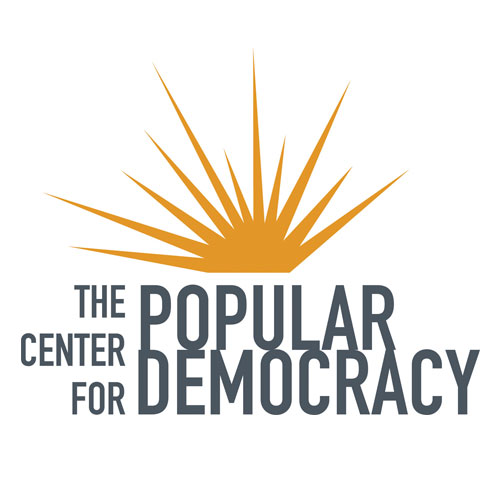As Puerto Rico Erupts in Protests, “La Junta” Eyes More Power

As Puerto Rico Erupts in Protests, “La Junta” Eyes More Power
“This is a moment when we have people rising up and saying they want to have power to make their own decisions,” Julio...
“This is a moment when we have people rising up and saying they want to have power to make their own decisions,” Julio López Varona, a lawyer and San Juan-based organizer with Construyamos Otro Acuerdo and the Center for Popular Democracy, told me. “People are not in the streets because they want more federal control. They are in the streets because they want a say in their future.”
Read the full article here.
Judge halts Puerto Rico bankruptcy process for 3 months

Judge halts Puerto Rico bankruptcy process for 3 months
The director of community dignity campaigns of the Center For Popular Democracy and spokesperson for the Construyamos...
The director of community dignity campaigns of the Center For Popular Democracy and spokesperson for the Construyamos otro Acuerdo campaign, lawyer Julio López Varona…
Read the full article here.
Piden a jueza Swain paralización de procesos de quiebra

Piden a jueza Swain paralización de procesos de quiebra
Mientras, el abogado Julio López Varona, director de Campañas Comunitarias del Center for Popular Democracy, enfatizó...
Mientras, el abogado Julio López Varona, director de Campañas Comunitarias del Center for Popular Democracy, enfatizó en la importancia de paralizar los procesos de bancarrota en momentos de incertidumbre sobre quién será el próximo gobernador y los representantes de la Junta de Control Fiscal.
Lee el artículo completo aquí.
Big Banks Are Divesting From Private Prisons, Thanks to Anti-ICE Activism

Big Banks Are Divesting From Private Prisons, Thanks to Anti-ICE Activism
Major private prison firms CoreCivic and GEO Group stand to lose 72 percent — about $1.9 billion — of their private...
Major private prison firms CoreCivic and GEO Group stand to lose 72 percent — about $1.9 billion — of their private financing as major banks commit to divesting from the private prison industry under pressure from activists, according to a new analysis by the Center for Popular Democracy and other groups.
Read the full article here.
The Fed — Yes, the Fed — Can Help Fix Inequality
“I think [Powell’s remarks] are a real vindication,” says Connie Razza, the chief of campaigns and policy at the Center...
“I think [Powell’s remarks] are a real vindication,” says Connie Razza, the chief of campaigns and policy at the Center for Popular Democracy, a liberal advocacy organization. “To have him acknowledge that lower-income communities are just entering a recovery is very important.”
In North County budgets, policing most expensive line item

In North County budgets, policing most expensive line item
“Budgets are moral documents that reflect the values and priorities of our government, yet for communities of color,...
“Budgets are moral documents that reflect the values and priorities of our government, yet for communities of color, local budgets have too often come to represent their further oppression,” Jennifer Epps-Addison, co-executive director of the Center for Popular Democracy, said in a press release about a 2017 report the group published examining budget expenditures in 12 different metropolitan areas nationwide. “In the wake of constant stories of police brutality and state violence, or news of departmental corruption and malfeasance, it is past time for us to start reimagining what safety means, how it is being resourced, and who is defining it.”
Read the full article here.
Many Shortfalls Of Wage Theft Enforcement For Migrant Workers

Many Shortfalls Of Wage Theft Enforcement For Migrant Workers
Make the Road New York and the Center for Popular Democracy compiled a report in April 2019 that estimated wage theft...
Make the Road New York and the Center for Popular Democracy compiled a report in April 2019 that estimated wage theft impacts around 2.1 million workers in New York every year, totaling more than $3.3 billion in stolen wages.
Read the full article here.
Financial transparency becomes an obstacle for private prison reform

Financial transparency becomes an obstacle for private prison reform
A new report from The Center for Popular Democracy (CPD) verifies that while private prison facilities contain a range...
A new report from The Center for Popular Democracy (CPD) verifies that while private prison facilities contain a range of violations, these institutions are significantly hindered by recent banking divestments to the tune of almost $1.93 billion.
Read the full article here.
New KPFA documentary highlights how Oakland’s unhoused face untold cycles of displacement; Plus: Protesters in Puerto Rico have given the Governor an ultimatum

New KPFA documentary highlights how Oakland’s unhoused face untold cycles of displacement; Plus: Protesters in Puerto Rico have given the Governor an ultimatum
Xiomara Caro Diaz is an organizer and activist, and a program director with the Center for Popular Democracy. She joins...
Xiomara Caro Diaz is an organizer and activist, and a program director with the Center for Popular Democracy. She joins us live from the streets in San Juan, Puerto Rico to discuss the demands for the resignation of Governor Ricardo Rosselló.
Listen to the story and read the transcript here.
Corruption, Mismanagement, and Disrespect Fuel Puerto Rico Protests

Corruption, Mismanagement, and Disrespect Fuel Puerto Rico Protests
“Joining me now to discuss the recent events in Puerto Rico is Julio Lopez Varona. He’s a Co-Director of campaigns at...
“Joining me now to discuss the recent events in Puerto Rico is Julio Lopez Varona. He’s a Co-Director of campaigns at the Center for Popular Democracy, which organizes the Puerto Rican community in the US to advocate for a just recovery for the island. He joins us today from San Juan, Puerto Rico.”
Listen to the story and read the transcript here.






13 hours ago
2 days ago